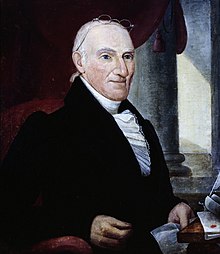Montfort Stokes
Montfort Stokes (born March 12, 1762 in Lunenburg County , Colony of Virginia , † November 4, 1842 in Fort Gibson , Indian Territory ) was an American politician and the 25th governor of North Carolina .
Military advancement
After elementary school, Montfort Stokes joined the newly formed American Merchant Navy at the age of thirteen. During the American Revolutionary War, he was captured by the British as an American marine and interned on a warship for seven months. Stokes remained connected to the military in the following years. He was, among other things, a captain (captain) of a cavalry unit and from 1804 to 1816 Major General in the National Guard of North Carolina. He also took part in the war of 1812 against the British.
Civil life
After the end of the Revolutionary War, he settled in Salisbury , North Carolina. There he was first a farmer and then a clerk at the Higher Regional Court of Rowan County (Clerk of the Superior Court of Rowan County). During this time he first met a young aspiring lawyer named Andrew Jackson . Stokes now studied law himself. He rejected an election to the US Senate that took place in 1804. From 1805 to 1838 he was a curator at the University of North Carolina. He had been based in Wilkesboro since about 1812. From 1799 to 1816 he was an administrative clerk in the North Carolina Senate. Between 1816 and 1823 he represented his state in the US Senate in Washington, DC In 1826 he was a member of the North Carolina Parliament and from 1829 to 1830 he was in the Senate of that country.
North Carolina Governor
In 1830 he was elected governor of his country by the House of Representatives after a long discussion and only in the ninth ballot. One of his opponents was Richard Spaight junior , who also faced Stokes the following year and was again narrowly defeated. In his almost two-year tenure as governor, he campaigned for the expansion of the canal system along the coast of the country to improve the transport system. As a loyal supporter of President Andrew Jackson, he demonstratively supported him during the nullification crisis with South Carolina . The President thanked him by appointing him to the Indian Commission that oversaw the implementation of the Indian Removal Act . For this reason, Stokes resigned on November 19, 1832 just under a month before the end of his term as governor.
Further career
His new role led Stokes to Fort Gibson, which was then part of the Arkansas Territory and is now in Oklahoma . Here Stokes took care of the settlement of the Indian tribes expelled from the east. He died there in 1842. Montfort Stokes was married twice and had a total of eleven children.
literature
- Robert Sobel and John Raimo (Eds.): Biographical Directory of the Governors of the United States, 1789–1978. Volume 2, Meckler Books, Westport, Conn. 1978, 4 volumes
Web links
- Montfort Stokes in the Biographical Directory of the United States Congress (English)
- Montfort Stokes in the National Governor Association (English)
| personal data | |
|---|---|
| SURNAME | Stokes, Montfort |
| BRIEF DESCRIPTION | North Carolina Governor |
| DATE OF BIRTH | March 12, 1762 |
| PLACE OF BIRTH | Lunenburg County , Virginia |
| DATE OF DEATH | November 4, 1842 |
| Place of death | Fort Gibson , Oklahoma |


